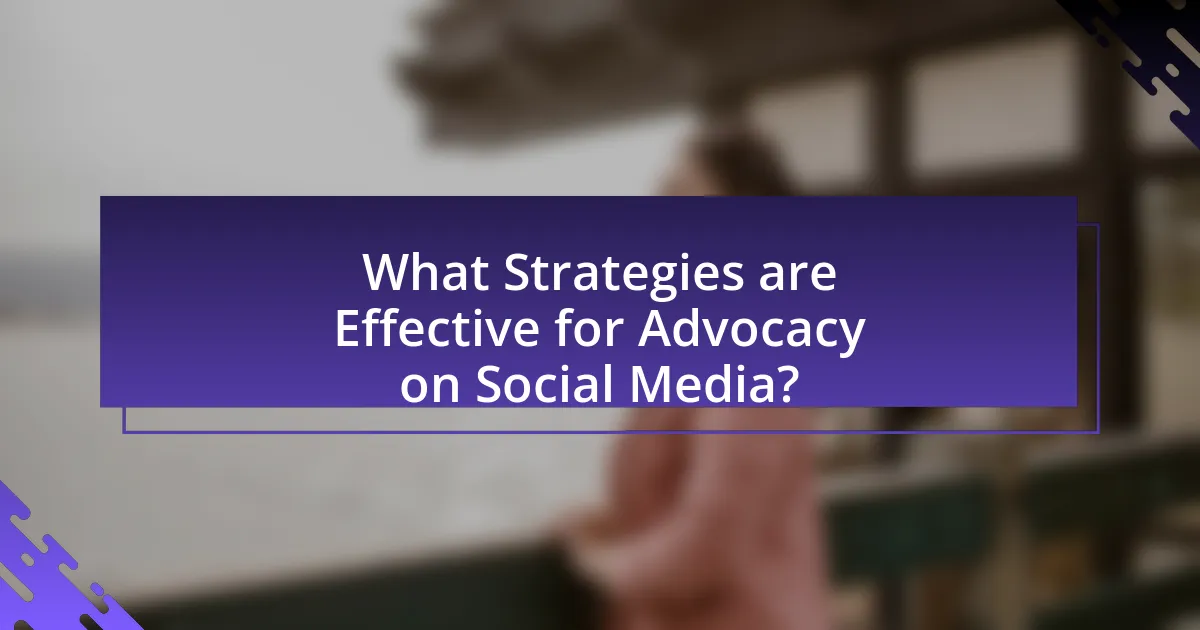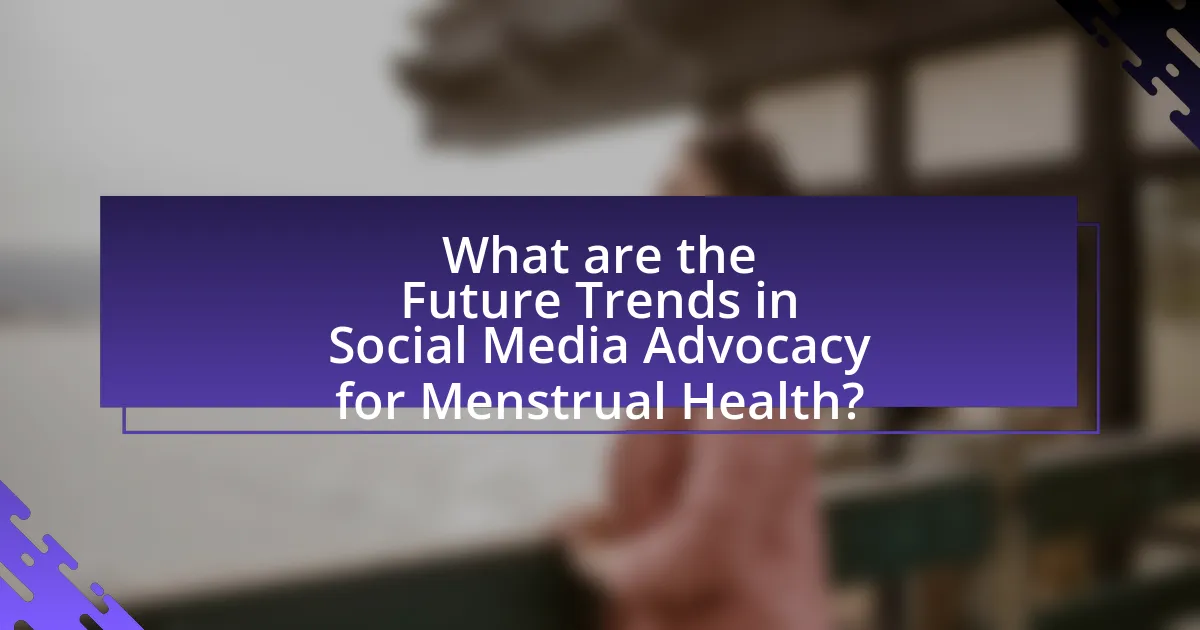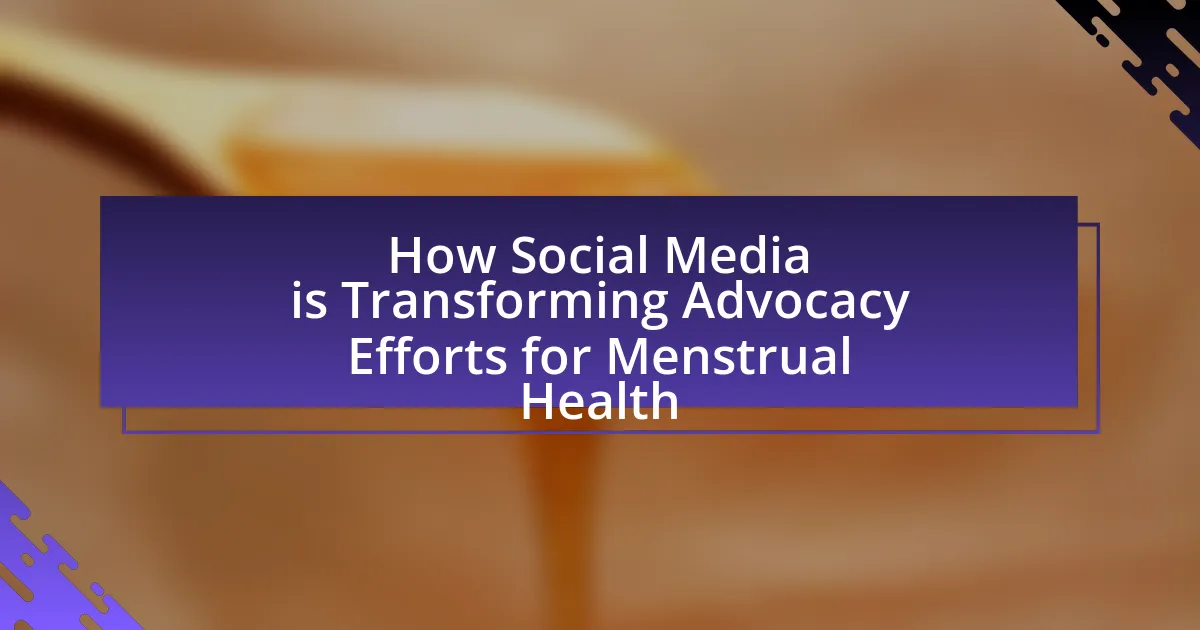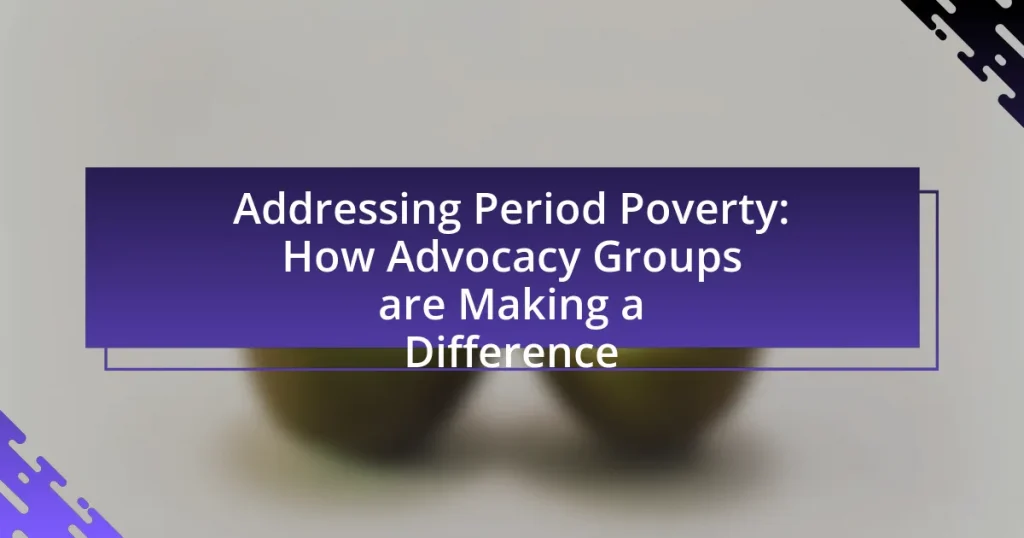Social media is transforming advocacy efforts for menstrual health by providing platforms for awareness, education, and community support. Campaigns utilizing hashtags like #PeriodPoverty and #MenstrualHealth have increased visibility and reduced stigma surrounding menstruation, leading to greater public discourse and policy attention. The article explores the role of social media in raising awareness, the effectiveness of various content types, the challenges faced by advocates, and the impact of technology and grassroots movements on future advocacy strategies. It emphasizes the importance of authentic engagement and data analytics in enhancing advocacy efforts for menstrual health.

How is Social Media Influencing Advocacy for Menstrual Health?
Social media is significantly influencing advocacy for menstrual health by providing a platform for awareness, education, and community support. Through campaigns and hashtags like #PeriodPoverty and #MenstrualHealth, individuals and organizations can share personal stories, disseminate information, and mobilize resources, thereby increasing visibility and reducing stigma around menstruation. Research indicates that social media campaigns have led to increased public discourse and policy attention on menstrual health issues, as seen in initiatives by organizations such as Plan International and the Menstrual Health Hub, which leverage social media to reach broader audiences and engage stakeholders effectively.
What role does social media play in raising awareness about menstrual health?
Social media plays a crucial role in raising awareness about menstrual health by providing a platform for education, advocacy, and community support. It enables individuals and organizations to share information, personal experiences, and resources related to menstrual health, thereby reducing stigma and promoting open discussions. For instance, campaigns like #PeriodPositive and #MenstrualHealth have successfully reached millions, fostering a global dialogue on menstrual hygiene management and health education. Research indicates that social media can significantly influence public perceptions and behaviors, as seen in a study published in the Journal of Health Communication, which found that social media campaigns effectively increased knowledge and awareness about menstrual health issues among diverse populations.
How do social media platforms facilitate discussions on menstrual health?
Social media platforms facilitate discussions on menstrual health by providing accessible spaces for individuals to share experiences, seek information, and engage in dialogue. These platforms enable users to connect with communities that focus on menstrual health, allowing for the exchange of personal stories and expert advice. For instance, hashtags like #MenstrualHealth and #PeriodPoverty have been used to raise awareness and mobilize support, leading to increased visibility of menstrual health issues. Research indicates that social media campaigns can significantly influence public perception and policy discussions surrounding menstrual health, demonstrating their effectiveness as advocacy tools.
What types of content are most effective in promoting menstrual health awareness?
Visual content, such as infographics and videos, is most effective in promoting menstrual health awareness. Research indicates that visual formats enhance engagement and retention of information, making complex topics more accessible. For instance, a study published in the Journal of Health Communication found that infographics increased understanding of menstrual health issues by 50% compared to text-only content. Additionally, personal stories shared through social media platforms foster community and reduce stigma, as evidenced by campaigns like #PeriodProud, which have successfully raised awareness and encouraged open discussions about menstruation.
Why is social media a powerful tool for advocacy in menstrual health?
Social media is a powerful tool for advocacy in menstrual health because it facilitates widespread awareness and engagement on the topic. Platforms like Twitter, Instagram, and Facebook allow advocates to share personal stories, educational content, and resources, reaching diverse audiences quickly. For instance, campaigns such as #PeriodPositive have mobilized thousands to discuss menstrual health openly, breaking taboos and fostering community support. Additionally, social media analytics show that posts related to menstrual health can achieve high engagement rates, amplifying the message and encouraging dialogue. This ability to connect individuals and organizations globally enhances the impact of advocacy efforts, making social media an essential component in promoting menstrual health awareness.
How does social media democratize access to information on menstrual health?
Social media democratizes access to information on menstrual health by providing a platform where individuals can share knowledge, experiences, and resources without traditional barriers. This accessibility allows users to engage with diverse perspectives and expert insights, fostering a more informed community. For instance, platforms like Instagram and Twitter host campaigns and discussions that reach millions, breaking the silence around menstrual health issues that were previously stigmatized. Research indicates that social media can enhance health literacy; a study published in the Journal of Medical Internet Research found that users who engage with health-related content on social media report increased awareness and understanding of health topics, including menstrual health.
What impact does social media have on stigma surrounding menstruation?
Social media significantly reduces the stigma surrounding menstruation by facilitating open discussions and increasing visibility of menstrual health issues. Platforms like Instagram and Twitter allow individuals and organizations to share personal experiences, educational content, and advocacy campaigns, which challenge traditional taboos. For instance, campaigns such as #PeriodPositive and #MenstrualHealth have garnered millions of interactions, promoting awareness and normalizing conversations about menstruation. Research indicates that increased online dialogue correlates with a decrease in stigma, as evidenced by a study published in the Journal of Health Communication, which found that social media engagement led to more positive attitudes towards menstruation among participants.
What challenges do advocates face when using social media for menstrual health?
Advocates face significant challenges when using social media for menstrual health, primarily due to stigma, misinformation, and platform restrictions. Stigma surrounding menstruation often leads to limited engagement and reluctance from audiences to participate in discussions. Misinformation can spread rapidly on social media, complicating efforts to provide accurate information about menstrual health. Additionally, social media platforms may impose restrictions on content related to sexual and reproductive health, limiting the visibility of advocacy messages. These challenges hinder the effectiveness of advocacy efforts aimed at promoting menstrual health awareness and education.
How can misinformation on social media affect menstrual health advocacy?
Misinformation on social media can significantly undermine menstrual health advocacy by spreading false narratives that confuse and mislead the public. This confusion can lead to stigmatization of menstrual health issues, as individuals may internalize incorrect information, resulting in reduced willingness to seek help or discuss menstrual health openly. For instance, studies have shown that misinformation can perpetuate myths about menstruation, such as the belief that menstruation is inherently dirty or shameful, which can discourage individuals from engaging in advocacy efforts. Furthermore, when inaccurate information is widely shared, it can drown out credible sources, making it difficult for accurate health information to reach the intended audience. This dynamic can ultimately hinder progress in menstrual health advocacy, as it creates barriers to education and awareness that are essential for promoting understanding and support for menstrual health issues.
What are the risks of online harassment for advocates in this space?
Online harassment poses significant risks for advocates in the menstrual health space, including psychological distress, reputational damage, and potential silencing of important voices. Advocates often face targeted attacks that can lead to anxiety, depression, and burnout, as evidenced by studies showing that 40% of women in advocacy roles report experiencing online harassment. This harassment can undermine their credibility and influence, making it difficult to engage effectively with their audience and achieve advocacy goals. Furthermore, the fear of harassment can deter individuals from participating in advocacy, ultimately stifling progress in menstrual health awareness and education.

What Strategies are Effective for Advocacy on Social Media?
Effective strategies for advocacy on social media include creating engaging content, utilizing hashtags, collaborating with influencers, and fostering community engagement. Engaging content, such as informative graphics and personal stories, captures attention and encourages sharing, which amplifies the message. The use of relevant hashtags increases visibility and connects the advocacy efforts to broader conversations, making it easier for users to find and participate in discussions. Collaborating with influencers who align with the advocacy goals can leverage their established audiences to reach more people. Additionally, fostering community engagement through interactive posts, Q&A sessions, and responding to comments builds a supportive environment that encourages ongoing dialogue and participation. These strategies have been shown to enhance the effectiveness of advocacy campaigns, as evidenced by successful movements that have gained traction through social media platforms.
How can advocates create engaging content for menstrual health campaigns?
Advocates can create engaging content for menstrual health campaigns by utilizing storytelling, interactive formats, and data-driven insights. Storytelling allows advocates to share personal experiences and relatable narratives, which can foster emotional connections with the audience. Interactive formats, such as polls, quizzes, and live Q&A sessions, encourage audience participation and enhance engagement. Data-driven insights, including statistics about menstrual health issues, can provide credibility and raise awareness about the importance of the topic. For instance, a campaign that highlights that 1 in 4 girls in developing countries miss school during their periods can effectively illustrate the urgency of addressing menstrual health.
What types of visuals resonate most with audiences regarding menstrual health?
Infographics and educational illustrations resonate most with audiences regarding menstrual health. These visuals effectively convey complex information in a simplified manner, making it easier for viewers to understand topics such as menstrual cycles, hygiene practices, and health implications. Research indicates that infographics can increase information retention by up to 65% compared to text alone, highlighting their effectiveness in educational contexts. Additionally, relatable imagery, such as diverse representations of individuals experiencing menstruation, fosters inclusivity and connection, enhancing audience engagement.
How can storytelling enhance the impact of menstrual health advocacy?
Storytelling enhances the impact of menstrual health advocacy by creating emotional connections that resonate with audiences, making the subject more relatable and engaging. When individuals share personal experiences related to menstrual health, it humanizes the issue, fostering empathy and understanding among listeners. Research indicates that narratives can significantly influence attitudes and behaviors; for instance, a study published in the Journal of Health Communication found that storytelling can increase awareness and reduce stigma surrounding health topics. By utilizing storytelling in social media campaigns, advocates can effectively reach and mobilize communities, driving conversations and promoting positive change in menstrual health awareness.
What role do influencers play in menstrual health advocacy on social media?
Influencers play a crucial role in menstrual health advocacy on social media by raising awareness, normalizing conversations, and providing education about menstrual health issues. They leverage their platforms to share personal experiences, challenge stigmas, and promote products or initiatives that support menstrual health. For instance, campaigns led by influencers have been shown to increase engagement and reach, as evidenced by a study from the Journal of Medical Internet Research, which found that social media influencers can significantly impact public perceptions and knowledge regarding health topics. This demonstrates that influencers are effective in mobilizing communities and fostering dialogue around menstrual health, ultimately contributing to greater societal acceptance and understanding.
How can partnerships with influencers amplify advocacy messages?
Partnerships with influencers can amplify advocacy messages by leveraging their established credibility and reach within specific communities. Influencers possess the ability to engage their followers authentically, which can enhance the visibility and relatability of advocacy campaigns. For instance, a study by the Pew Research Center indicates that 70% of teens trust influencers more than traditional celebrities, making influencer partnerships particularly effective in reaching younger audiences. Additionally, influencers can create tailored content that resonates with their audience, thereby increasing the likelihood of message retention and action. This strategic collaboration not only broadens the audience but also fosters a sense of community around the advocacy issue, ultimately driving greater awareness and support for menstrual health initiatives.
What criteria should advocates consider when collaborating with influencers?
Advocates should consider the influencer’s audience alignment, engagement rates, and authenticity when collaborating with influencers. Audience alignment ensures that the influencer’s followers are interested in menstrual health, which increases the likelihood of effective communication. Engagement rates indicate how actively the influencer interacts with their audience, reflecting their influence and ability to drive conversations. Authenticity is crucial, as influencers who genuinely support menstrual health issues can foster trust and credibility, making their endorsements more impactful. Research shows that 70% of consumers trust influencers more than traditional advertisements, highlighting the importance of these criteria in successful collaborations.
How can data analytics improve social media advocacy efforts?
Data analytics can significantly enhance social media advocacy efforts by providing insights into audience behavior and engagement patterns. By analyzing metrics such as likes, shares, comments, and demographic data, organizations can tailor their messaging to resonate more effectively with their target audience. For instance, a study by the Pew Research Center found that 69% of adults in the U.S. use social media, indicating a vast potential audience for advocacy campaigns. Furthermore, data analytics allows for real-time monitoring of campaign performance, enabling quick adjustments to strategies based on what content performs best. This data-driven approach not only increases the reach and impact of advocacy efforts but also fosters a more engaged community around menstrual health issues.
What metrics should advocates track to measure the success of their campaigns?
Advocates should track engagement metrics, reach metrics, conversion metrics, and sentiment analysis to measure the success of their campaigns. Engagement metrics, such as likes, shares, and comments, indicate how well the audience interacts with the content. Reach metrics, including impressions and follower growth, show the extent of the campaign’s visibility. Conversion metrics, such as sign-ups or donations, reflect the campaign’s effectiveness in prompting action. Sentiment analysis helps assess public perception and emotional response to the campaign. These metrics collectively provide a comprehensive view of campaign performance and impact in the context of social media advocacy for menstrual health.
How can feedback from social media audiences shape future advocacy strategies?
Feedback from social media audiences can significantly shape future advocacy strategies by providing real-time insights into public sentiment and preferences. This feedback allows advocates to identify key issues, adjust messaging, and tailor campaigns to resonate more effectively with their target audience. For instance, a study by the Pew Research Center found that 69% of adults in the U.S. use social media, making it a vital platform for gauging public opinion. By analyzing comments, shares, and engagement metrics, advocates can refine their approaches, ensuring that their strategies align with the values and concerns expressed by the community. This iterative process enhances the relevance and impact of advocacy efforts in promoting menstrual health.

What are the Future Trends in Social Media Advocacy for Menstrual Health?
Future trends in social media advocacy for menstrual health include increased use of interactive content, personalized messaging, and the integration of technology such as AI-driven chatbots. Interactive content, such as polls and quizzes, engages users and fosters community participation, while personalized messaging allows advocates to tailor information to specific demographics, enhancing relevance and impact. The integration of AI-driven chatbots can provide immediate support and information, making resources more accessible. According to a 2022 study by the Pew Research Center, 69% of adults in the U.S. use social media, indicating a significant platform for advocacy efforts. These trends suggest a shift towards more engaging, tailored, and accessible approaches in promoting menstrual health awareness.
How is technology evolving to support menstrual health advocacy on social media?
Technology is evolving to support menstrual health advocacy on social media through the development of specialized apps, data analytics, and enhanced communication tools. These advancements enable users to track menstrual cycles, share personal experiences, and access educational resources, fostering a community of support and awareness. For instance, apps like Clue and Flo not only provide cycle tracking but also include features for sharing insights and connecting with others, which has been shown to increase engagement in menstrual health discussions. Additionally, social media platforms are implementing algorithms that promote menstrual health content, making it more visible and accessible to a broader audience, thereby amplifying advocacy efforts.
What emerging platforms could change the landscape of menstrual health advocacy?
Emerging platforms such as TikTok, Instagram, and Clubhouse could significantly change the landscape of menstrual health advocacy. TikTok’s short-form video format allows for creative and engaging content that can quickly spread awareness and destigmatize menstrual health issues among younger audiences. Instagram’s visual storytelling capabilities enable advocates to share personal experiences and educational content, fostering community support and dialogue. Clubhouse, as an audio-based platform, facilitates real-time discussions and expert panels, allowing for deeper engagement and knowledge sharing on menstrual health topics. These platforms collectively enhance visibility, accessibility, and community involvement in menstrual health advocacy.
How can advancements in data privacy impact advocacy efforts?
Advancements in data privacy can significantly enhance advocacy efforts by fostering trust and encouraging participation among individuals. When data privacy measures are strengthened, advocates can assure potential supporters that their personal information will be protected, leading to increased engagement in campaigns. For instance, a study by the Pew Research Center found that 79% of Americans are concerned about how their data is being used, indicating that robust privacy protections can alleviate these concerns and motivate individuals to participate in advocacy initiatives. Furthermore, enhanced data privacy can facilitate more open discussions about sensitive topics, such as menstrual health, by creating a safe environment for sharing personal experiences without fear of exposure. This, in turn, can lead to more effective advocacy strategies and broader community support.
What are the potential long-term effects of social media on menstrual health awareness?
Social media can significantly enhance long-term awareness of menstrual health by facilitating open discussions and sharing of information. This platform allows individuals to access diverse perspectives, educational resources, and personal experiences related to menstrual health, which can lead to increased knowledge and reduced stigma. Research indicates that social media campaigns, such as #PeriodPositive, have successfully raised awareness and encouraged conversations about menstruation, thereby promoting better understanding and acceptance of menstrual health issues. Furthermore, studies show that increased visibility of menstrual health topics on social media correlates with improved health literacy among users, ultimately leading to more informed health choices and advocacy for menstrual health rights.
How might social media shape public policy regarding menstrual health in the future?
Social media may significantly shape public policy regarding menstrual health in the future by amplifying awareness and mobilizing advocacy efforts. Platforms like Twitter and Instagram enable individuals and organizations to share personal experiences and information about menstrual health, which can lead to increased public discourse and visibility on the topic. For instance, campaigns such as #PeriodPoverty have successfully highlighted the challenges faced by individuals who cannot afford menstrual products, prompting policymakers to consider legislative changes. Research indicates that social media campaigns can influence public opinion and encourage political action, as seen in various health-related movements. This growing engagement can lead to more informed policy decisions that address menstrual health needs, ultimately fostering a more supportive environment for those affected.
What role will grassroots movements play in the future of menstrual health advocacy?
Grassroots movements will play a crucial role in the future of menstrual health advocacy by amplifying voices, raising awareness, and driving policy changes at local and national levels. These movements often leverage social media platforms to mobilize communities, share personal stories, and educate the public about menstrual health issues, thereby fostering a sense of solidarity and urgency. For instance, campaigns like “Menstrual Hygiene Day” have successfully utilized grassroots efforts to highlight the importance of menstrual health, leading to increased visibility and support from policymakers. Additionally, grassroots organizations often address specific cultural and regional challenges, tailoring their advocacy to meet the unique needs of their communities, which enhances the effectiveness of their initiatives.
What best practices should advocates follow for effective social media engagement?
Advocates should prioritize authenticity, consistency, and audience engagement for effective social media engagement. Authenticity builds trust, as followers are more likely to connect with genuine voices rather than corporate-sounding messages. Consistency in posting helps maintain visibility and keeps the audience informed about ongoing advocacy efforts. Engaging with the audience through comments, shares, and direct messages fosters a sense of community and encourages participation in advocacy initiatives. Research indicates that organizations that actively engage with their audience see a 20-30% increase in follower interaction, demonstrating the effectiveness of these practices in enhancing social media presence and impact.
How can advocates maintain authenticity while promoting menstrual health online?
Advocates can maintain authenticity while promoting menstrual health online by sharing personal experiences and using transparent communication. Personal narratives resonate with audiences, fostering trust and relatability, as evidenced by studies showing that storytelling enhances engagement in health advocacy. Additionally, advocates should provide evidence-based information and cite reputable sources, ensuring that their content is credible and informative. This approach not only reinforces their authenticity but also empowers their audience with accurate knowledge, aligning with the growing demand for transparency in health discussions.
What strategies can ensure sustained engagement with audiences on menstrual health issues?
To ensure sustained engagement with audiences on menstrual health issues, organizations should implement interactive content, community building, and educational campaigns. Interactive content, such as polls and quizzes, encourages participation and keeps audiences involved. Community building through social media groups fosters a sense of belonging and support among individuals discussing menstrual health. Educational campaigns that provide accurate information and address misconceptions can maintain interest and promote ongoing dialogue. For instance, a study by the American Journal of Public Health found that educational interventions significantly increased knowledge and engagement in health topics, demonstrating the effectiveness of these strategies in maintaining audience interest.



